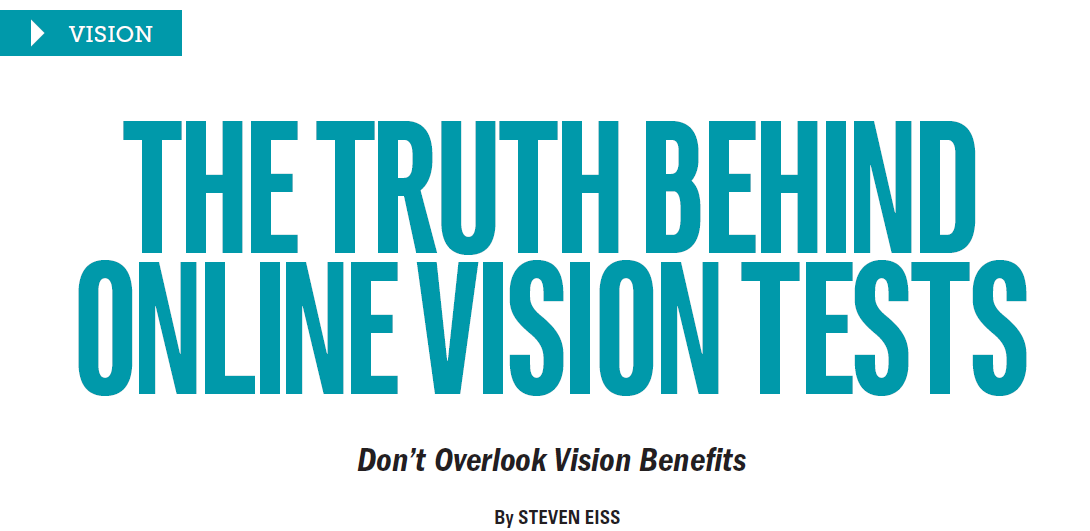In today’s fast-paced world, we need to be more efficient than ever to get things done. Certain technology advancements have been a game-changer to achieve this—from grocery delivery, to streaming services, smart homes and subscription boxes. When it comes to our health, though, that can be a different story. While it’s easy to fall into the convenience trap, there is still no substitute for meeting with a healthcare professional in-person. Case in point: online vision screenings.
According to research from Transitions Optical and the American Optometric Association (AOA), there is a lack of understanding about—and need for education on—the importance of comprehensive eye exams. The 2019 Transitions Employee Perceptions of Vision Benefits survey (conducted by Wakefield Research on behalf of Transitions Optical) indicated that half of employees think that online vision screenings that provide a prescription are a suitable replacement for in-office eye exams. The truth is, this is not the case.
As online vision screenings become part of the vision benefits conversation, it is imperative that employees, employers and providers understand the difference between an online vision screening and an in-person, comprehensive eye exam with an eye doctor.
Understanding the Difference
Usually, an online eye test measures the sharpness of your vision, as well as imperfections that cause blurred vision. While this is helpful to see your best, it’s missing a big factor: assessing the health of your eyes. According to the AOA, online vision tests often give misleading information. They can delay essential, sight-saving treatment—meaning they are not a substitute for an in-person, comprehensive eye exam by an eye doctor.
Regular, comprehensive eye exams with an eye care professional are the best way to preserve vision and assess eye health. Not only do they measure for vision sharpness and imperfections that cause blurred vision, but they also measure a plethora of other essential items. The American Academy of Ophthalmology® (AAO) notes that these exams include looking at the pupils, side vision, eye movement and pressure; looking at the front part of the eye to check for cataract and any cornea scratches; and finally, dilating eye drops to examine the retina and optic nerve for signs of damage (see aao.org). Not only this, but comprehensive, dilated eye exams can uncover problems even before symptoms occur—and can even provide early detection of serious health issues, like diabetes.
Periodic eye and vision examinations are an important part of preventive health care. Many eye and vision problems have no obvious signs or symptoms, so many may not even know that a problem exists. Early diagnosis and treatment of eye and vision problems can help prevent vision loss.
According to healthysightworkingforyou.org, common eye diseases that can be detected through a regular eye exam include:
- Cataracts: The leading cause of blindness; this occurs when the lens of the eye becomes cloudy
- Glaucoma: Increased pressure within the eyeball and the second-leading cause of blindness
- Age-Related Macular Degeneration: Painlessly destroys sharp, central vision
More serious and costly health conditions that can be detected by a comprehensive eye exam include:
- Diabetes: Can lead to problems in the eye, such as diabetic retinopathy, cataract, glaucoma and age-related macular degeneration
- Hypertension: Also known as high blood pressure, hypertension impacts the eye as well as the body. Without treatment, it can lead to bleeding in the eye, blurred vision, or even blindness
As mentioned, half of employees from the survey believe that online vision screenings that provide a prescription are a suitable replacement for in-office eye exams. Millennials were the most likely to agree (57 percent)—compared to half of Gen Z, Gen X and 36 percent of Boomers.
What employees want: tips for education
The misunderstanding of the difference between an in-person eye exam with an eyecare professional and an online vision screening emphasizes the importance of education.
Provide up-to-date eye health information
Three in four employees say that their eye doctor is their source for information about eye health (71 percent). The second-largest source? Their vision plan provider. One in three employees indicated that is where they get eye health information, so it’s important that vision plans are providing the most accurate information about online vision screenings.
Stay consistent with ongoing education
When open enrollment comes around, this is a great time to discuss benefit options—but it typically only comes once a year. Discussing the importance of routine eye care year-round can help remind employees about how a comprehensive eye exam with an eye doctor is their best bet to not only see well, but also to stay well. The AOA doctor locator at www.aoa.org also has an easily searchable database of doctors to provide employees with.
Offer a comprehensive vision benefits package
Low in cost, vision benefits offer a high return-on-investment for employers. Vision benefits can help to save on medical costs, boost employee productivity, and can even help to attract and retain top talent.
According to inc.com, 44% of Gen Z employees (who are ages 18-24 and expected to comprise one-fifth of the workforce by 2021 said that whether a company offers vision benefits has been an important factor in their decision to accept a job.
When selecting eyewear, an overwhelming 94 percent of employees say that premium lens options are important to them—making vision plans that cover these a key differentiator for employers. Among the most desired premium lens options include:
- Scratch-resistant lenses: 73 percent of employees
- Anti-reflective or no-glare coatings: 71 percent of employees
- Photochromic lenses, like Transitions® Light Intelligent Lenses™: 43 percent of employees
- Blue light protection: 35 percent of employees
Health over convenience
Technology is essential these days in getting more done. But when it comes to eye health, and overall health, there is no replacement for an in-person, comprehensive exam with an eye doctor. Without this, the employee is at risk of missing out on early detection of potentially sight or even life-threatening conditions. You can help employers eliminate a step for their employees by providing education on eye health, and the importance of offering a comprehensive vision benefits package.
To help elevate the importance of comprehensive eye exams and quality eyewear available through vision benefits, Transitions Optical offers a variety of employee and employer focused tools and education. These can be accessed, free of charge, at HealthySightWorkingforYou.org.
Steven Eiss, OD, Third Party Committee Chair, American Optometric Association,
is a graduate of Muhlenberg College and the Pennsylvania College of Optometry. He is an active member of the Pennsylvania Optometric Association, where he is currently serving on the board of directors as a trustee. He is also active in the American Optometric Association and the Bucks-Mont Optometric Society, where he has held the office of president and treasurer. Dr. Eiss was named the Optometrist of the Year by the Pennsylvania Optometric Association in 2010.


